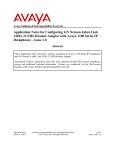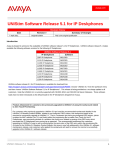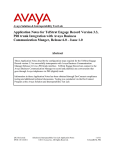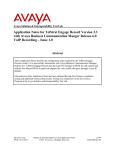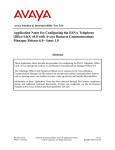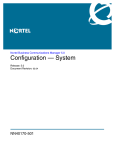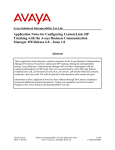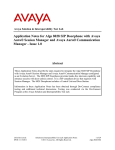Download Avaya R6.0 Application Note
Transcript
Avaya Solution & Interoperability Test Lab Application Notes for Avaya Business Communications Manager 450 R6.0 to support BT Wholesale/HIPCOM SIP Trunk Service – Issue 1.1 Abstract These Application Notes describe the steps to configure Session Initiation Protocol (SIP) Trunking between BT Wholesale (BTW)/HIPCOM SIP Trunk Service and an Avaya SIP enabled Enterprise Solution. The Avaya solution consists of Avaya Business Communications Manager 450. BT is a member of the DevConnect Service Provider program. Information in these Application Notes has been obtained through DevConnect compliance testing and additional technical discussions. Testing was conducted via the DevConnect lab. HD; Reviewed: SPOC 2/1/2012 Solution & Interoperability Test Lab Application Notes ©2012 Avaya Inc. All Rights Reserved. 1 of 30 HIPBCM450 1. Introduction These Application Notes describe the steps to configure Session Initiation Protocol (SIP) trunking between BT Wholesale/HIPCOM SIP Trunk Service and an Avaya SIP enabled enterprise solution. The Avaya solution consists of Avaya Business Communications Server (BCM) 450 connected to BT Wholesale/HIPCOM SIP Trunk Service. Customers using this Avaya SIP-enabled enterprise solution with BT Wholesale/HIPCOM’s SIP Trunk Service are able to place and receive PSTN calls via a dedicated Internet connection and the SIP protocol. This converged network solution is an alternative to traditional PSTN trunks. This approach normally results in lower cost for the enterprise. 2. General Test Approach and Test Results The general test approach was to configure a simulated enterprise site using an Avaya SIP telephony solution consisting of BCM 450. The enterprise site was configured to use the SIP Trunk Service provided by BTW/HIPCOM. 2.1. Interoperability Compliance Testing The interoperability test included the following: Incoming calls to the enterprise site from the PSTN were routed to the DID numbers assigned by BTW/HIPCOM. Incoming PSTN calls were made to Unistim, Digital and analog telephones at the enterprise. Outgoing calls from the enterprise to the PSTN were made from Unistim, Digital and analog telephones. G.729 annex b (silence suppression) is not supported by BTW/HIPCOM’s SIP Trunk Service and thus was not tested. Calls using G.729 and G.711A codecs were tested. Fax calls to/from a Group 3 fax machine to a PSTN connected fax machine using the T.38 mode. User features such as hold and resume, transfer, conference, call forwarding, etc. were tested. Caller ID Presentation and Caller ID Restriction features were tested. Call coverage and call forwarding for endpoints at the enterprise site was tested. 2.2. Test Results Interoperability testing of the sample configuration was completed with successful results for BTW/HIPCOM SIP Trunk Service with no observations seen. HD; Reviewed: SPOC 2/1/2012 Solution & Interoperability Test Lab Application Notes ©2012 Avaya Inc. All Rights Reserved. 2 of 30 HIPBCM450 2.3. Support For technical support on BTW/HIPCOM products please contact the following website: http://www.hipcom.co.uk/support or http://ipvoicesupport.btwholesale.com. 3. Reference Configuration Figure 1 illustrates the test configuration. The test configuration shows an enterprise site connected to BTW/HIPCOM using SIP Trunks. Located at the enterprise site is a BCM 450. Endpoints are Avaya 1140, i2004 and i2007 series IP Deskphones with Unistim firmware, Avaya IP Softphones 2050, Avaya Digital telephone, Analog telephone and fax machine. For security purposes, any public IP addresses or PSTN routable phone numbers used in the compliance test are not shown in these Application Notes. Hipcom SIP Trunk Service Avaya Business Communications Manager (BCM450) Acme Packet Session Director 4500 Console LI NK Alarm Mgmt 0 Mgmt 1 Mgmt 2 ACT LINK S0P0 ACT LINK S0P1 ACT LINK S1P0 ACT IP Network S1P1 192.168.81.200 Broadsoft 192.168.81.2XX PSTN Analog Phone #1 Analog Phone #2 Analog Fax Machine MobilePhone Fax 2500 (Analog) 2005 T7316 Digital 2007 1140E (IP) 2004 I2004 (IP) Figure 1: BT Wholesale/HIPCOM SIP Trunk topology with Avaya Business Communication Manager 450 HD; Reviewed: SPOC 2/1/2012 Solution & Interoperability Test Lab Application Notes ©2012 Avaya Inc. All Rights Reserved. 3 of 30 HIPBCM450 4. Equipment and Software Validated The following equipment and software were used for the sample configuration provided. Equipment Avaya Business Communications Manager 450 R6.0 Standard System Base Unit Avaya 1140E Avaya i2004 Avaya i2007 Avaya 2050 IP Softphone Avaya T7316 (Digital) BTW/HIPCOM SIP Trunk Service Software Avaya Business Communications Manager 450 R6.0 System Software Version 10.0.1.02.120 Manufacturing SW Version 450.06 UNISTIM /Firmware: 0625C70 UNISTIM /Firmware: 0602B76 UNISTIM /Firmware: 0621C8D Release 4.0.2.0062 Release 01 Acme Packet 4500 Net-Net SBC - version SCX6.1.0 Broadsoft - version 14 Service Pack 9 Configuration version - HIPCOM v8.1 Note: BCM450 and BCM50 use the same software stream on BCM Release 6.0. The SIP Trunking implementations on both platforms use the same components and behave the same. 5. Configure Avaya Business Communication Manager These Application Notes assume that the basic configuration of the BCM 450 system has already been administered and the system has working lines and handsets. For further information on Avaya Business Communication Manager 450, please consult references in Section 9. The below procedures describe the configuration details of BCM 450 with Public SIP trunks connecting to BTW/HIPCOM SIP Trunk Service. Accessing the BCM 450 system Administer BCM SIP Trunk Keycodes Administer BCM Business Name Administer BCM Trunk Routes Administer BCM Destination Codes Administer BCM SIP Trunks Settings o Administer IP Trunks General o Administer SIP Account – Parent and Child o Administer BCM SIP Trunks Global Settings o Administer SIP Trunks Media Parameters o Administer SIP Trunks Private Administer Dialing Plan Private Network Settings Administer BCM Handset Settings HD; Reviewed: SPOC 2/1/2012 Solution & Interoperability Test Lab Application Notes ©2012 Avaya Inc. All Rights Reserved. 4 of 30 HIPBCM450 5.1. Accessing the Avaya Business Communication Manager 450 5.1.1. Install Business Element Manager and Avaya Business Communication Manager 450 Monitor Open web browser and connect to the Web GUI https://<BCM 450 IP address> as shown below. Login using the appropriate Username and Password. Note: The web browser has to enable Java Runtime Environment to support the BCM 450 Web GUI. On first time of login, the user will be prompted for a username and password, along with the opportunity to save these credentials and set this web page for auto login in the future. HD; Reviewed: SPOC 2/1/2012 Solution & Interoperability Test Lab Application Notes ©2012 Avaya Inc. All Rights Reserved. 5 of 30 HIPBCM450 The Welcome to BCM page is displayed. From the Applications area select Business Element Manager, and then click Run as highlighted below. This action will install Business Element Manager to the local PC. After the installation complete, Business Element Manager shortcut will be created on the desktop. 5.1.2. Create a new Network Element Entry for Business Element Manager Once the software has been installed, double click on the Business Element Manager desktop icon; the Avaya Business Element Manager – Network Elements screen will open. It is necessary to create a Network Element to connect to the BCM 450 system. To do this, highlight Network Element, and right click and select New Network Element Business Communications Manager. HD; Reviewed: SPOC 2/1/2012 Solution & Interoperability Test Lab Application Notes ©2012 Avaya Inc. All Rights Reserved. 6 of 30 HIPBCM450 Input the IP address of BCM 450, username: nnadmin and appropriate password in the relevant fields. Then click OK. 5.1.3. Login to Business Element Manager Double click on the Business Element Manager desktop icon; select the Network Element then click Connect as shown below. HD; Reviewed: SPOC 2/1/2012 Solution & Interoperability Test Lab Application Notes ©2012 Avaya Inc. All Rights Reserved. 7 of 30 HIPBCM450 After the connection has been established, click OK in the Confirm dialog (not shown). It may also be necessary to validate the Device at this stage. Click on the Validate Device button at the top of the screen. 5.1.4. Login to Avaya Business Communication Manager 450 Monitor The BCM Monitor is a useful tool for monitoring the lines in and out of the BCM. The software may be installed via the web page to a local PC. (See Section 5.1.1 - the BCM Monitor is listed below the BCM Element Manager and is installed the same way). Once the software has been installed double click the BCM 450 Monitor icon on the desktop. Then input IP address of BCM 450, username: nnadmin and appropriate password. HD; Reviewed: SPOC 2/1/2012 Solution & Interoperability Test Lab Application Notes ©2012 Avaya Inc. All Rights Reserved. 8 of 30 HIPBCM450 The BCM Monitor can also be accessed via the BCM Element Manager screens. From the Task Navigation Panel, click on the Administration Tab. Select Utilities BCM Monitor. Click on the Launch BCM Monitor button that appears on the right hand side of the screen. A number of tabs are available once connected. Besides the BCM Info tab, the RTP Sessions and Line Monitor tabs show useful information on calls transiting the system. HD; Reviewed: SPOC 2/1/2012 Solution & Interoperability Test Lab Application Notes ©2012 Avaya Inc. All Rights Reserved. 9 of 30 HIPBCM450 5.2. Verify Avaya Business Communication Manager SIP Trunk Keycodes Keycodes are required in order to activate IP trunks on BCM. The VoIP GW Trunks license enables H.323 and SIP trunks. Alternatively a separate keycode is available to enable only SIP trunks. Ensure the BCM has the keycode installed prior to starting. If the required keycode is not installed, contact an authorized Avaya sales representative. Connect to BCM Business Element Manager. From the Task Navigation Panel select the Configuration Tab. From the sub menu select System Keycodes. Review the data column to display the number of VoIP GW trunks available and check the Status to confirm as Active. HD; Reviewed: SPOC 2/1/2012 Solution & Interoperability Test Lab Application Notes ©2012 Avaya Inc. All Rights Reserved. 10 of 30 HIPBCM450 This document assumes that the VoIP trunks are present and have been programmed onto the system. A check may be made by going to the Task Navigation Panel. From the Configuration tab select Telephony Lines Active VoIP Lines. The VoIP lines are displayed and the associated Line Type. By default, SIP lines are assigned to Bloc A. HD; Reviewed: SPOC 2/1/2012 Solution & Interoperability Test Lab Application Notes ©2012 Avaya Inc. All Rights Reserved. 11 of 30 HIPBCM450 5.3. Administer Avaya Business Communication Manager Business Name In order for the BCM to send CLID, a business name must be configured for the system. From the Task Navigation Panel select the Configuration Tab. From the sub menu select Telephony Global Settings Feature Settings. In field 1 of the Business Names area configure a suitable name. Note: Since Business Communication Manager concatenates the station name to the end of the Business Name in the SIP message and there is a fixed length for this concatenated string, using a short Business Name is recommended. HD; Reviewed: SPOC 2/1/2012 Solution & Interoperability Test Lab Application Notes ©2012 Avaya Inc. All Rights Reserved. 12 of 30 HIPBCM450 5.4. Administer Avaya Business Communication Manager Trunk Routes From the Task Navigation Panel select the Configuration Tab. Select Telephony Dialing Plan Routing. On the Routes tab, click Add to create a new route. (Add button at the bottom of the screen is not shown). Enter appropriate Route number in Route field and click OK to confirm change. Once the route has been created, it can be modified, by clicking into the relevant field. Set the Use Pool to BlocA and set DN Type to Public (Unknown). All SIP lines by default will go into BlocA. HD; Reviewed: SPOC 2/1/2012 Solution & Interoperability Test Lab Application Notes ©2012 Avaya Inc. All Rights Reserved. 13 of 30 HIPBCM450 Destination Codes were also added and linked to the newly created Route 001. Click on the Destination Codes tab in Dialing Plan - Routing. In the example below Destination Code 9 was created to access Normal Route 001 (which was created above). This is shown below: 5.5. Administer Avaya Business Communication Manager SIP Trunks Settings 5.5.1. Administer IP Trunks General From the Task Navigation Panel select the Configuration Tab; select ResourcesIP TrunksGeneral. Click on the tab IP Trunk Settings. Set the following fields: Forward redirected OLI: Set to Last Redirect Send name display: Enabled with tick HD; Reviewed: SPOC 2/1/2012 Solution & Interoperability Test Lab Application Notes ©2012 Avaya Inc. All Rights Reserved. 14 of 30 HIPBCM450 5.5.2. Configure BCM Public SIP Account – Parent From the Task Navigation Panel select the Configuration Tab, then select Resources IP Trunks SIP Trunking and click on the Public tab in the right pane. Select the Accounts tab and click on Add and select No Template, as shown below. HD; Reviewed: SPOC 2/1/2012 Solution & Interoperability Test Lab Application Notes ©2012 Avaya Inc. All Rights Reserved. 15 of 30 HIPBCM450 The following window appears: Enter the following information in the fields: Name: Description: SIP domain: Registration required: SIP username: Password Enter a name for the new account e.g. BTW Enter a description e.g. BTWHIPCOM Enter the domain name that is going to be used. This is partially hidden for security purposes Enabled with tick Enter the SIP username provided by BTW/HIPCOM Enter the Password provided by BTW/HIPCOM NOTE – It is important not to click on the OK button in the above screen but hit the TAB key. The following window will appear, reconfirm the password. Click on the OK button as highlighted below when ready. HD; Reviewed: SPOC 2/1/2012 Solution & Interoperability Test Lab Application Notes ©2012 Avaya Inc. All Rights Reserved. 16 of 30 HIPBCM450 Once the account has been created basic information needs to be added. At the bottom pane of the Accounts window is where the Details for Account section can be found. Click on the Basic tab, as shown in the screen shot below. Enter the following values in the fields: Local: The local domain was the same as the Remote domain. This was configured when adding the SIP domain in Section 5.5.2, (hidden for security purposes) Proxy Address: IP address of proxy, this was given by BTW/HIPCOM, (hidden for security purposes) Proxy Port: 5060 Registrar Address: IP address of registrar, this was given by BTW/HIPCOM, (hidden for security purposes) Registrar Port: 5060 Also Advanced settings can be set. At the bottom pane of the Accounts window is where the Advanced section can be found. Click on the Advanced tab, this is shown in the screen shot below. The following values were set for the testing: HD; Reviewed: SPOC 2/1/2012 Solution & Interoperability Test Lab Application Notes ©2012 Avaya Inc. All Rights Reserved. 17 of 30 HIPBCM450 5.5.3. Configure BCM Public SIP Account – Child Child accounts need to be created for every DDI that is associated with a line on the BCM. Once the parent account has been created child accounts need to be added. At the bottom pane of the Accounts window is where the User Accounts section can be found. Click on the User Accounts tab and click on Add (not shown). A new window will appear, this is shown in the screen shot below. Enter the following values in the fields: Description: CLID: SIP Username: Auth Username: Auth Password: CLID Override: HD; Reviewed: SPOC 2/1/2012 Enter a name for this child account e.g. can be a DDI number or name. Enter the Public OLI number of an individual extension or extensions. This will match outgoing calls to a particular DDI (child account). Enter the SIP username provided by BTW/HIPCOM, same SIP Username configured in Section 5.5.2. The number inserted must be in the following format i.e. 441234567890. Enter the SIP username provided by BTW/HIPCOM, same Auth Username configured in Section 5.5.2. Enter the Password provided by BTW/HIPCOM ,same Auth Password confdigured in Section 5.5.2 Enter the DDI number that will be presented to the PSTN. The number inserted must be in the following format i.e. 441234567890. Solution & Interoperability Test Lab Application Notes ©2012 Avaya Inc. All Rights Reserved. 18 of 30 HIPBCM450 PAI CLID Override: Enter the DDI number you want to present to the PSTN. The number inserted must be in the following format i.e. 441234567890. Contact Override: Enter the DDI number you want to present to the PSTN. The number inserted must be in the following format i.e. 441234567890. Click OK to save changes. HD; Reviewed: SPOC 2/1/2012 Solution & Interoperability Test Lab Application Notes ©2012 Avaya Inc. All Rights Reserved. 19 of 30 HIPBCM450 5.5.4. Configure BCM Public Settings Check the Public Provisioned Port field is set to 5060. From the Task Navigation Panel select the Configuration Tab then select Resources IP Trunks SIP Trunking. Under the Public tab, click on the Settings tab in the right pane as shown below. HD; Reviewed: SPOC 2/1/2012 Solution & Interoperability Test Lab Application Notes ©2012 Avaya Inc. All Rights Reserved. 20 of 30 HIPBCM450 5.5.5. Configure BCM SIP Trunks Global Settings From the Task Navigation Panel select the Configuration Tab, then select Resources IP Trunks SIP Trunking and click on Global Settings tab. In the SIP Settings area, enter the following: Local Domain Leave blank Call Signaling Port Set to 5060 (Click the Modify button to alter) In the RFC2833 Area Dynamic Payload HD; Reviewed: SPOC 2/1/2012 Set to 101 Solution & Interoperability Test Lab Application Notes ©2012 Avaya Inc. All Rights Reserved. 21 of 30 HIPBCM450 5.5.6. Configure SIP Trunks Media Parameters From the Task Navigation Panel select the Configuration Tab, then select Resources IP Trunks SIP Trunking and click on Media Parameters tab. From the Preferred Codecs area, select the relevant codecs from the Available list and add to the Selected list. The codec order may be changed by using the Up/Down arrows. In the Settings area; Check whether Enable Voice Activity Detection (Silence Suppression) is ticked. Note: BTW/HIPCOM do not support this option, so it was left not ticked. Alter the codec payload size, if required. Set the Fax transport to T.38. Choose whether Provide in-band ringback should always be provided by the BCM on incoming SIP calls. (Default is unselected) HD; Reviewed: SPOC 2/1/2012 Solution & Interoperability Test Lab Application Notes ©2012 Avaya Inc. All Rights Reserved. 22 of 30 HIPBCM450 5.6. Configure Dialing Plan Public Network Settings From the Task Navigation Panel select the Configuration Tab. Select Telephony Dialing Plan Public Network. In the Public Network Settings area, set the following: Public Received number length: Public network dialing plan: Set to 4. The BCM will then match on the last 4 digits of the DDI number sent from BTW/HIPCOM Set to Public (Unknown) Click Add to save changes. HD; Reviewed: SPOC 2/1/2012 Solution & Interoperability Test Lab Application Notes ©2012 Avaya Inc. All Rights Reserved. 23 of 30 HIPBCM450 5.6.1. Configure Dialing Plan Public for Outgoing Calls To add a public route from the Task Navigation Panel select the Configuration tab, then select Resources IP Trunks SIP Trunking and click on the Public tab in the right pane. Select Routing Table tab and click on Add (not shown). Enter the following fields in Add Route window: Name: Enter a name for the route, e.g. international Destination Digits: Prefix of the digits that are going to use this route e.g. 00 ITSP Account Associate with the ITSP account that was created in Section 5.5.2 Click OK to save changes. As shown in the screen shot below, a local route that uses prefix digits of 0203 had been previously added. HD; Reviewed: SPOC 2/1/2012 Solution & Interoperability Test Lab Application Notes ©2012 Avaya Inc. All Rights Reserved. 24 of 30 HIPBCM450 5.7. Configure Avaya Business Communication Manager Handset Settings This document assumes that handsets are programmed and already working on the system and have being assigned a line. So this section concentrates on settings on the handsets which may need to be checked to ensure operability with the settings described in previous sections. From the Task Navigation Panel select the Configuration Tab, select Telephony Sets Active Sets. Click once on an extension from the list of available Active Sets. Click on the Line Access tab. Set the following: Pub Receieved #: Set this to be the last 4 digits of the DDI number that is going to be received by the BCM from the PSTN. The Pub Received number is allocated to a target line, which can be allocated to an individual or multiple extensions. Maps incoming calls to particular extension(s). Note: field is located in Line Assignment Tab located in the (lower half of the screen). Pub OLI: Set to same value as Pub Received # In the Line Assignment Tab, select Caller ID Set. This ensures the BCM handset will display the incoming callers name or extension number or line number on the BCM handset. HD; Reviewed: SPOC 2/1/2012 Solution & Interoperability Test Lab Application Notes ©2012 Avaya Inc. All Rights Reserved. 25 of 30 HIPBCM450 Next, select the Line Pool Access tab. By default, SIP Lines/trunks are put into pool BlocA on the BCM 450. Sets do not automatically have access to this pool, so access permissions must be added to BlocA on a set by set basis. Click on the Add button and in the pop up window; enter the name of the Line Pool. Click OK to confirm. HD; Reviewed: SPOC 2/1/2012 Solution & Interoperability Test Lab Application Notes ©2012 Avaya Inc. All Rights Reserved. 26 of 30 HIPBCM450 Next, click on the Capabilities and Preference tab at the top of the screen. In the top half of the screen, set the following fields First Display Set to Name, Number or Line. This determines what incoming details from the calling handset will be displayed on the BCM Handset Auto Called ID Enabled (to see the CLID of internal telephones ) In the lower half of the screen, set the field Allow redirect, enabled with a Tick. This permits the BCM 450 handset to use Call Forward Always. HD; Reviewed: SPOC 2/1/2012 Solution & Interoperability Test Lab Application Notes ©2012 Avaya Inc. All Rights Reserved. 27 of 30 HIPBCM450 6. BT Wholesale/HIPCOM Service Provider Configuration The configuration of BTW/HIPCOM’s equipment used to support the SIP trunk service is outside of the scope for these Application Notes and will not be covered. To obtain further information on BTW/HIPCOM’s equipment and system configuration please contact an authorised BTW/HIPCOM representative. 7. Verification Steps This section provides details on how to verify the main configuration setup of the BCM 450 SIP trunk with BTW/HIPCOM’s SBC. 7.1. Verify Avaya Business Communication Manager SIP Trunk To verify that the sip trunk is up and operational, set up test calls between the BCM handsets and the PSTN and ensure that these calls route out over the sip trunk. From the Task Navigation Panel select the Configuration Tab, then select Resources IP Trunks SIP Trunking and click on the Public tab in the right pane. Select the Accounts tab and select the account that was created in Section 5.5.2. In the bottom pane in the Details for Account section, click on User Accounts. Verify that under Status is showing as displayed Registered with xx.xx.xx.xx:5060, where xx.xx.xx.xx is the Registrar IP address configured in Section 5.5.2. To monitor traffic between BCM 450 and BTW/HIPCOM use the BCM Line Monitor to determine the incoming and outgoing line numbers and the RTP sessions tab. HD; Reviewed: SPOC 2/1/2012 Solution & Interoperability Test Lab Application Notes ©2012 Avaya Inc. All Rights Reserved. 28 of 30 HIPBCM450 8. Conclusion These Application Notes describe the configuration necessary to connect Avaya Business Communication Manager 450 to BTW/HIPCOM’s SIP Service. Please refer to Section 2 for observations from testing. 9. Additional References Product Documentation for Avaya Products, including BCM 450 may be found at http://support.avaya.com [1] Avaya Business Communications Manager 6.0 Configuration —Telephony NN40170502 Document issue: 03.03 Document date: October 2010 Product release: 6.0 [2] Avaya Business Communications Manager 450 6.0 Installation — System NN40170303 Document issue: 03.03 Document date: February 2011 Product release: 6.0 [3] Avaya Business Communications Manager 6.0 Planning and Engineering NN40170200 Document issue: 02.03 Document date: May 2010 Product release: 6.0 HD; Reviewed: SPOC 2/1/2012 Solution & Interoperability Test Lab Application Notes ©2012 Avaya Inc. All Rights Reserved. 29 of 30 HIPBCM450 ©2012 Avaya Inc. All Rights Reserved. Avaya and the Avaya Logo are trademarks of Avaya Inc. All trademarks identified by ® and ™ are registered trademarks or trademarks, respectively, of Avaya Inc. All other trademarks are the property of their respective owners. The information provided in these Application Notes is subject to change without notice. The configurations, technical data, and recommendations provided in these Application Notes are believed to be accurate and dependable, but are presented without express or implied warranty. Users are responsible for their application of any products specified in these Application Notes. Please e-mail any questions or comments pertaining to these Application Notes along with the full title name and filename, located in the lower right corner, directly to the Avaya DevConnect Program at [email protected]. HD; Reviewed: SPOC 2/1/2012 Solution & Interoperability Test Lab Application Notes ©2012 Avaya Inc. All Rights Reserved. 30 of 30 HIPBCM450






























